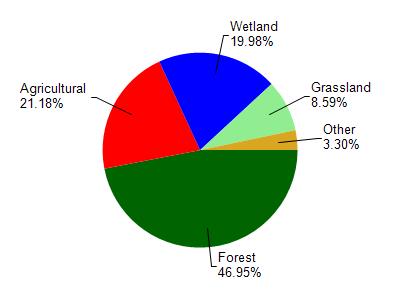Waushara
No
No
No
Fish and Aquatic Life
Overview
Turtle Lake, in the White River Watershed, is a 6.32 acre lake that falls in Waushara County. This lake is managed for fishing and swimming and is currently not considered impaired.
Date 2011
Author Aquatic Biologist
Historical Description
A small, deep hard water seepage lake located about three miles northwest of Wautoma. The lake basin drops off rapidly with more than 75 percent greater than 20 feet deep. The littoral bottom materials are primarily muck and sand. A thermocline develops at 13 feet. The fishery includes largemouth bass, bluegill, pumpkinseed and green sunfish. Muskrats frequent the lake, mallards and bluewing teal nest near it. Some spring and fall migrating puddle ducks stop. Hunting is allowed with permission. There are no cottages or dwellings on the lake. There is no public access. Source: 1970, Surface Water Resources of Waushara County Turtle Lake T-19-N, R-10-E, Sections 20, 29 Surface Acres = 5.8; S.D.F. = 1.15; Maximum Depth = 27 feet
Date 1970
Author Surface Water Inventory Of Wisconsin
Condition
Wisconsin has over 84,000 miles of streams, 15,000 lakes and milllions of acres of wetlands. Assessing the condition of this vast amount of water is challenging. The state's water monitoring program uses a media-based, cross-program approach to analyze water condition. An updated monitoring strategy (2015-2020) is now available. Compliance with Clean Water Act fishable, swimmable standards are located in the Executive Summary of Water Condition in 2018. See also the 'monitoring and projects' tab.
Management Goals
Wisconsin's Water Quality Standards provide qualitative and quantitative goals for waters that are protective of Fishable, Swimmable conditions [Learn more]. Waters that do not meet water quality standards are considered impaired and restoration actions are planned and carried out until the water is once again fishable and swimmable
Management goals can include creation or implementation of a Total Maximum Daily Load analysis, a Nine Key Element Plan, or other restoration work, education and outreach and more. If specific recommendations exist for this water, they will be displayed below online.
Monitoring
Monitoring the condition of a river, stream, or lake includes gathering physical, chemical, biological, and habitat data. Comprehensive studies often gather all these parameters in great detail, while lighter assessment events will involve sampling physical, chemical and biological data such as macroinvertebrates. Aquatic macroinvertebrates and fish communities integrate watershed or catchment condition, providing great insight into overall ecosystem health. Chemical and habitat parameters tell researchers more about human induced problems including contaminated runoff, point source dischargers, or habitat issues that foster or limit the potential of aquatic communities to thrive in a given area. Wisconsin's Water Monitoring Strategy was recenty updated.
Grants and Management Projects
| Project Name (Click for Details) | Year Started |
|---|
|
|
Monitoring Projects
| WBIC | Official Waterbody Name | Station ID | Station Name | Earliest Fieldwork Date | Latest Fieldwork Date | View Station | View Data |
|---|
| 108100 | Turtle Lake | 10007410 | Turtle Lake | 7/27/1999 | 9/14/2014 | Map | Data |
|

Watershed Characteristics
Turtle Lake is located in the White River watershed which is 149.81 mi². Land use in the watershed is primarily forest (47%), agricultural (21.20%) and a mix of wetland (20%) and other uses (11.90%). This watershed has 156.65 stream miles, 1,017.38 lake acres and 18,495.17 wetland acres.
Nonpoint Source Characteristics
This watershed is ranked Not Ranked for runoff impacts on streams, Not Ranked for runoff impacts on lakes and High for runoff impacts on groundwater and therefore has an overall rank of High. This value can be used in ranking the watershed or individual waterbodies for grant funding under state and county programs.However, all waters are affected by diffuse pollutant sources regardless of initial water quality. Applications for specific runoff projects under state or county grant programs may be pursued. For more information, go to surface water program grants.